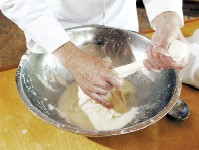Once a month, Chez Philippe takes a break from its French-Asian cuisine to give diners the opportunity to sample the foods of places such as Thailand, Italy, Portugal, and Africa.
This month’s dinner, on August 24th, will showcase the food of Cuba, which will be a culinary homecoming for Reinaldo Alfonso, Chez Philippe’s chef de cuisine. Alfonso grew up in Miami surrounded by the food of his family’s home country and was inspired by his mother’s and grandmother’s cooking. It’s only natural that he take family and childhood favorites to the Chez Philippe level of top-notch artistic presentation and fine-dining standards.
“Cuban food is Creole food. We actually called it Criolla,” explains Alfonso. “Now, you don’t want to get that mixed up with Louisiana’s Creole cuisine. Criolla is influenced by the foods of the Caribbean and Spain. In Cuban cuisine, you’ll find a lot of Spanish influences. The difference is that our food is more exotic and uses more spices — cinnamon is one example. So, Cuban food is not spicy food; we just use spices to give the dish a greater depth of flavor.”
The dinners are five-course meals with two choices for each course. Green plantain soup with roasted snapper, camarone enchilado with pan cubano, boliche with boniato puree, lime juice and brown-sugar bananas, and natilla are some of the dishes that will be on the menu for that night.
“The base for the soup is a sofrito,” says Alfonso. “Most of our dishes have a sofrito base, either green or red, which is made with onions, peppers, tomatoes, garlic, wine, and herbs. The green sofrito uses a lot of parsley and cilantro. We use sofrito in our cooking, and the French use a mirepoix [celery, onions, carrots].
“The camarone enchilado is my dad’s signature enchilado. It’s like a warm shrimp cocktail, for which the shrimp are stewed in a red sofrito with cinnamon, cumin, and lots of herbs. Boliche is like a pot roast, only I’ll be braising a chorizo-stuffed eye-round, which is served with white sweet-potato puree. Natilla, one of the desserts for the night, is a cinnamon custard that will probably be paired with lemon guava shortbread.”
The Taste of Cuba dinner at Chez Philippe is on Thursday, August 24th, from 5 to 10 p.m. The cost is $65 per person plus tax and gratuity. There are two more world dinners this year: a Taste of India on September 21st and a Taste of Italy on October 19th.
Chez Philippe in The Peabody (529-4188)
Culinary students and chefs who have an interest in foods from Spain, listen up! This is your chance to win an all-expense-paid trip to the 2006 Worlds of Flavor “Spain and the World Table” conference at the Culinary Institute of America in Napa Valley, November 2nd through the 4th.
What do you have to do? Create a recipe that highlights ingredients from Spain, and enter it into the 2006 A Taste of Spain Recipe Contest. Some of the ingredients to choose from include Spanish olive oil, olives, pimentón (smoked paprika), saffron, and cheeses.
The deadline to enter is at 10 p.m. August 29th. Winners will be announced on or after October 2nd.
This weekend, the Southern Foodways Alliance is hosting Camp Nashville in conjunction with the East Nashville Tomato Art Festival. According to the SFA, campers will be in for “smooth-as-silk Tennessee whiskey and hickory-smoked barbecue; tomato-themed parades and catfish-stuffed BLTs; hot, hot chicken and cold, cold beer.”
The camp highlights Southern food favorites and will feature such luminaries as E.W. Mayo, “the king of fried sweet-potato pies.” Noted food writer John Egerton will moderate a session on meat-and-threes. Other topics include barbecue, beer, and pimiento cheese. There will also be a BLT tasting, dinner at Arnold’s, and a hot chicken run and guitar pull to make sure that the campers stay busy and well-fed.
Southern Foodways Alliance Camp Nashville is August 11th and 12th.
